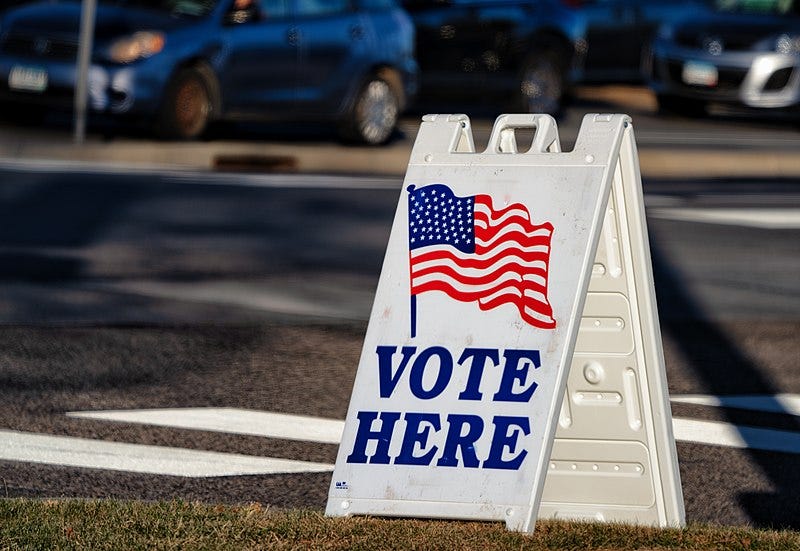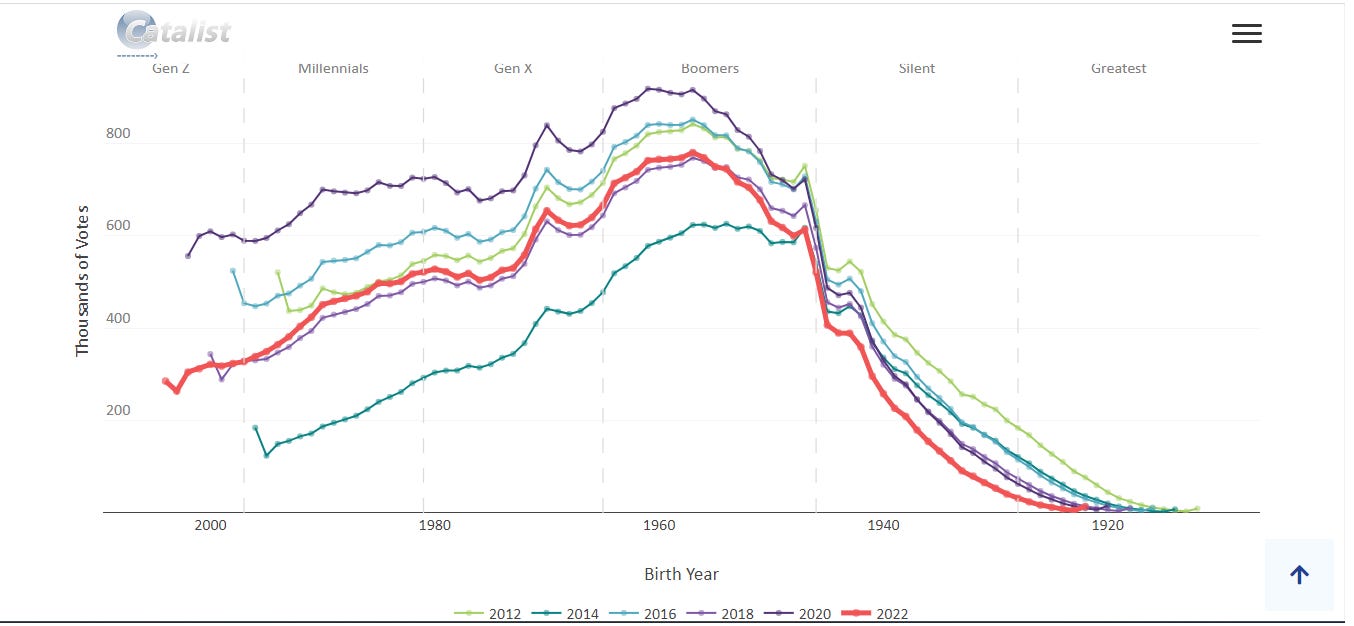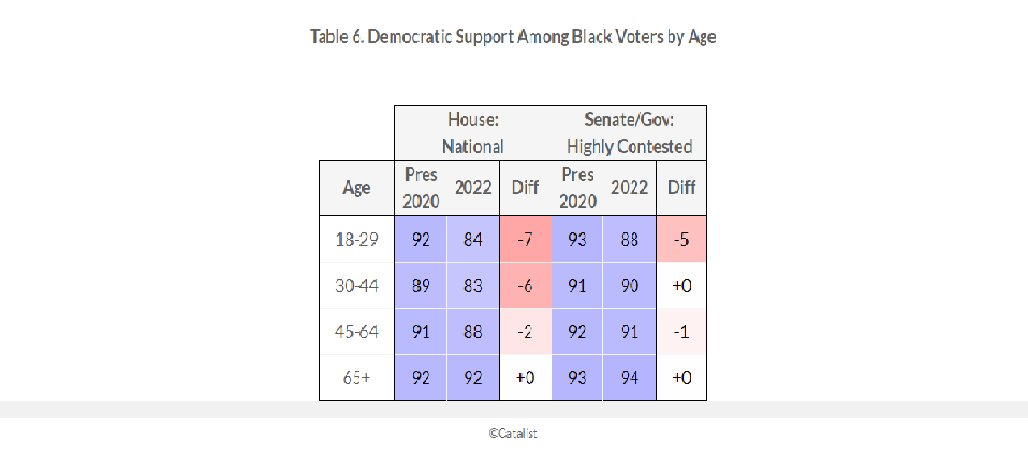The 2022 Midterm Demographic Data Shows How The GOP Should Be Worried about 2024
A deep dive into the GOP's problems with key voter groups.

No Scores of the Week this week. Instead, below is a deep dive into electoral politics…
Parties that control the House, Senate, and the White House historically face a bruising at the polls in midterm elections. The modern era is littered with midterm elections that saw massive seat losses in Congress for the party in power. In 1994, the Bill Clinton-led Democrats lost control of the House and Senate, with a massive 54-seat loss in the House. In 2006, the sixth year of the Bush 43 Presidency, Republicans lost both chambers, losing 31 seats in the House. In 2010, Barack Obama’s Democrats lost control of the House, with a net gain of 63 seats for the GOP. And in 2018, the Donald Trump-led GOP lost 41 House seats and House control.
In all these midterm losses, the incumbent president had an approval rating below 50 percent and a majority of American voters disapproved of the job the president was doing. Midterms tend to be referendums on the incumbent president where voters take out their frustration on the president’s party in Congress. Historically, midterm elections have been challenging for the ruling party as the opposition tends to unite against them. The party in power often becomes divided which results in a turnout differential that benefits the opposition party.
2022, at least early in the year, seemed to be setting up for a similar story for President Biden and Democrats. Biden’s approval rating was where George W. Bush’s was in 2006 when his party lost badly. Most voters said the country was on the wrong track. Inflation was weighing heavily on voters’ minds.
But Democrats defied history. They did lose the House but only barely, with the GOP gaining way fewer seats than many expected. And Democrats gained one seat in the Senate, winning most swing state Senate races; the GOP failed to defeat a single Democratic incumbent Senator. Democrats flipped state legislative chambers and defended Governor’s offices in key battlegrounds. While there was a Republican advantage in turnout as expected in a Democratic midterm, independents were split, a break from midterms past when they voted strongly against the party in power. Despite a 44% approval rating for President Biden according to exit polls, a not-so-insignificant chunk of Biden disapprovers voted for Democrats, also a break from previous midterms. It was the best midterm for a party in power since 2002, when President Bush’s Republicans benefitted from Bush’s popularity after 9/11.
There has been a lot of discussion about the factors that contributed to this result: the threat to abortion rights after the Dobbs decision in the early summer, Donald Trump’s endorsements of weak Senate candidates, and the toxicity of the Trump GOP brand among swing voters. These were all factors that helped Democrats do better than expected. But this article will look at the numbers behind the results.
Elections are decided by two factors from a mechanical standpoint: who votes (Do enough Democrats/Republicans turn out? Is the electorate more college-educated or less college-educated?) and how do key voter groups vote (Who do Independents choose? What kind of margins do Democrats run up among black voters?).
Earlier this week, Democratically-aligned data shop Catalist released their report on the 2022 elections “What Happened™ in 2022”, addressing the demographics of the 2022 electorate and how key groups voted to produce the result we saw. I will look at some of the key findings from the report but encourage you to read it all here.
Their data analysis is so credible because they use the “longest-running voter file outside the two major political parties.” For this study, they note:
Team members acquire voter file data from all 50 states and Washington, DC, including local and county-level data, as well as precinct-level election results. Data scientists and other technical experts standardize and process these data across the voter file, including running data through record-linkage algorithms and relating commercial, Census and other data back to voter file records. Using precinct-level voting records, survey data and other Catalist data and models, data scientists carefully reconstruct What Happened in a given election based on all available data, building up from the precinct level and down from national results to build a coherent view of the electorate.
A notable aspect of the 2022 election was that there was no national wave, unlike in previous midterms. This meant that the results in competitive races were not necessarily similar to those in non-competitive races. The study notes, “Republicans enjoyed an overall advantage nationally, but Democrats outperformed them in highly contested races, where Democratic turnout and support levels were higher.” In fact, the data showed that in the “most heavily contested Senate and Gubernatorial elections, Democrats did slightly better (51.0%) than they did in the 2020 Presidential election (50.5%).”
A big reason for this is that Democratic base turnout, while far from ideal, was larger than expected for a Democratic midterm. In addition, persuadable voters turned out to vote for the party in power at a better-than-expected rate. Democrats were able to effectively neutralize headwinds against them through effective contrast campaigning. The evidence for this is that they did better in races seen as heavily contested where they spent more resources on campaign tactics and strategies. In other words, campaigns still matter.
Turnout was a part of the story. The study points out the following:
When looking at the percent of eligible people that voted, turnout was also higher than any midterm since 1970, save 2018. However, these national turnout numbers mask important differences at the state and congressional level: namely, that turnout matched or even exceeded 2018 turnout in the most highly contested elections in the country.
The authors of this study say that we are in a high turnout era, partially driven by an influx of new registrants after the 2016 election:
The high turnout era has been marked by millions of new voters entering — and staying in — the electorate. In 2022, 17 million votes (21% of the total) came from people who registered in 2018, 2020, and 2022. Since 2016, millions of new voters have entered the electorate, at rates much higher than previous midterm and presidential years. Once these new voters have registered and cast their first ballots, they are much more likely to keep participating in elections.
Part of the story of turnout in elections inevitably focuses on youth voter turnout. We know historically that young voter turnout is lower in midterms than in presidential elections. That was the case here again. But it didn’t drop through the floor like it did in midterm elections where Democrats lost badly (think 2010 and 2014). In fact, the study’s authors point out:
In heavily contested races, turnout among Gen Z and Millennials went up, exceeding 2018’s “Blue Wave” high water mark. This can be seen in the line graph below, highlighting trends from the most contested states. Here, we track turnout by birth year, making generational cohorts comparable over time. The turnout curves for 2022 and 2018 are strikingly similar; they remain substantially higher than 2014, even approaching the Presidential election of 2012.

And Democrats expanded their support among young voters (age 18-29) by 3 points over President Biden’s vote share with them. Democrats won 65% of voters under 30 - a margin combined with the decent turnout among these voters that allowed Democrats to counter their losses with older voters since 2020. As the authors note, this is a historic development:
Support has remained incredibly strong since 2016, however, notably including the past two midterms: peaking at 68% in the wave year of 2018, and remaining high in 2022. This marks the first time that young people's Democratic support has been greater than 60% for two consecutive midterm elections, and now includes a midterm with a Democratic incumbent president.
It's worth noting that the Millennial/Gen Z voting population has increased as older voters pass away, and as Millennials age into the demographic that tends to have higher voting rates. And the Millennial part of the electorate remains very Democratic after moving toward Democrats at the tail end of the Bush presidency and the 2008 election of Barack Obama. Gen Z entering the electorate has made the 18-29 age group even more Democratic. The Catalist data showed that Democrats did slightly better among voters age 18-29 than they did among all Gen Z and Millennial voters. Remember, Millennials aren’t the kids anymore for the most part. The youngest of my generation is around 26. Most voters under 30 are likely Gen Z. This generation came of voting age during the rise of Donald Trump and the worry for Republicans should be that an unpopular Trump presidency has turned off older Gen Z voters just as the Bush presidency weakened the GOP’s brand with older Millennials.
One of the defining features of the modern electorate is its increasing racial diversity, although midterms tend to have a whiter electorate. According to the Catalist data, “White voters comprised 76% of the 2022 electorate, up a point since 2018.” So a slightly whiter electorate showed up. But again, in more contested races, there was a smaller shift on this measure, which likely helped Democrats in those contests. And in those more competitive races, Democrats outperformed President Biden’s vote share among white voters (42% in 2020 to 44% in 2022).
Among white voters, one of the biggest political divides is education levels. Over the last 20 years or so, but accelerated since Trump emerged as the Republican Party nominee in 2016, college-educated whites have trended in the Democrats’ direction while non-college-educated whites have become increasingly Republican. I think one of the most fascinating findings from the Catalist data is that in 2022, the gap between college whites and non-college whites actually decreased rather than increased. But again, the competitive races showed a slightly more positive performance for Democrats among non-college-educated whites. The study notes:
Similar to other demographic groups, there was a different story in highly contested Senate and gubernatorial races. Here, Democrats actually improved their vote share among white non-college voters (36% in 2020 to 40% in 2022), while slightly losing support among white college voters (53% in 2020 to 51% in 2022). Directionally, in both cases, the relative improvement came among white non-college voters.
The authors point out that this happened due to changes in how white women voted compared to how white men voted. Essentially, according to the data, in the most contested races, the Democrats shed support with college-educated white men, while continuing to gain support with college-educated white women. But the added wrinkle was that Democrats reduced GOP margins among non-college-educated white women.
That speaks to how abortion rights played a key role in the election outcome after the Dobbs decision from the Supreme Court striking down Roe v. Wade. As the authors note:
Overall, women voters pushed Democrats over the top in heavily contested races. While Democrats lost ground in the national House vote among both women (-2 points) and men (-4 points), they did better in highly contested Senate and Gubernatorial races. In the heavily contested top-ticket races, Democratic performance actually improved over 2020 among women, going from 55% to 57% support.”
Remember, many of the competitive gubernatorial races occurred in swing states where Republicans winning could have put abortion rights at greater risk due to the Republican legislatures in those states. Think Michigan, Wisconsin, and Pennsylvania - states with Democratic incumbent governors but Republican legislatures.
In Michigan, there was a referendum on the ballot to guarantee the right to abortion and other reproductive health services in the state constitution, a potential motivator for pro-choice voters in that state. In each of these states, Democratic gubernatorial candidates won. In Michigan and Pennsylvania, Democrats made significant state legislative seat gains. It appears as though there was a chunk of non-college-educated white women voters who typically vote Republican but who were motivated by their pro-choice positions. When abortion rights were not seemingly at stake, they voted Republican. But with abortion rights now on the line, they voted Democratic to protect abortion access. It also helped Democrats improve their performance among college-educated white women who are already fairly pro-choice but were now motivated to vote their anger and frustration over Roe being overturned.
The authors also argue that GOP candidates who were election deniers suffered a penalty with voters in competitive states and races. This was a fundamental part of the story of this election. Typically in midterm elections, the party out of power wins because enough voters trust that they are better than the controlling party and because the opposition party is able to make the election a pure referendum on the current party in power. Now I’m not saying some Republicans didn’t try that. But clearly, the message that broke through to enough persuadable voters was that Republicans are not a sensible alternative to Democrats because the GOP is still the party of Donald Trump, who was rejected by the voters in 2020.
Trump had a lower favorability rating among voters than Biden, according to the exit polls. Additionally, Trump’s involvement in the GOP primaries where many key candidates embraced his lies about the 2020 election proved to be a flashing red light to swing voters who were otherwise willing to give the GOP a chance. This turned the typical referendum midterm election into more of a choice election between the two parties. Again, the abortion issue played a role here as well. The most significant policy change of the first two years of the Biden presidency was not a Democratic initiative that Republicans could run against like they did with the Clinton budget in 1994 or ObamaCare in 2010. It was the decision of Supreme Court justices appointed by Republicans, most notably the three put on the Court by Trump, to overturn a national right to abortion.
I will point out that in the midst of a better-than-expected election for the Democratic Party, a warning sign for their party is the decline in both turnout and Democratic support among black voters. Going into the election, there was concern that the drop in support for Democrats among Latino voters we saw in 2020 would get worse. It didn’t really improve nationally but Democrats’ support among Latinos was basically unchanged from 2020. But among black voters, support dropped for Democrats compared to 2020. This was more the case with younger black voters, as seen in the chart below. Democrats still do very well among younger black voters, but the party would be well-advised to pay more attention to them and not take their support for granted.
So, what do the 2022 results tell us about 2024? First, keep in mind, that presidential-level turnout will be higher than it was in the 2022 midterms. So that’s an important caveat to anything I say here. Who the candidates are will also matter, and there may be unforeseen issues that upend the election.
The electorate will be a bit more non-college-educated, which could help Republicans if that increase is more among white non-college-educated voters. However, 2022 showed that Democrats can make some gains among non-college white female voters over the issue of abortion, especially in swing states. A Republican president could very well sign a national abortion ban if elected, which could allow President Biden and Democrats to rally these voters to vote against a GOP presidency.
In addition, younger voters will be a bigger part of the 2024 electorate than they were in 2022. And if they continue to cast their votes for Democrats at wide margins, that could make a real difference in important swing states that have younger populations like Georgia.
Getting younger voters of color to turn out will be critical to Democratic chances in 2024. This is especially true with younger black voters, who are critical voting blocs in states like Michigan, Pennsylvania, and Georgia. Democrats will need to maintain 2020 levels of support with Latino voters to hold Nevada and Arizona.
For Republicans, even as they gained with college-educated white men in 2022, their slippage with college-educated white women is hurting them in key battlegrounds in the upper Midwest and could doom them in North Carolina, a state Trump narrowly won but which recently passed a 12-week abortion ban.
2022 showed that, despite President Biden’s unpopularity, voters in the middle and core Democratic base voters (especially women voters) are willing to vote Democratic as a stop against the Trumpian Republican Party. It showed that many voters valued candidate quality and that campaigns cannot rely solely on mobilization to win. They have to persuade and can be successful if they are able to frame themselves as champions of the normies against extremism. It also showed that persuadable voters may be voting for good candidates and against extremism rather than just voting out the party in power because they are down on the president.
What that means in 2024 is left to be seen. But it shows that voters are probably looking intently at not just President Biden’s policies but are thinking of elections now as more of a choice. And with that in mind, they are not necessarily finding the GOP to be a trusted option.





